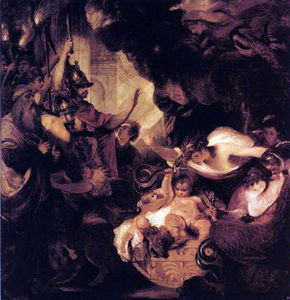The Infant Hercules Strangling Serpents in his Cradle Analysis
- Date of Creation:
- circa 1788
- Height (cm):
- 307.00
- Length (cm):
- 297.00
- Medium:
- Oil
- Support:
- Canvas
- Subject:
- Scenery
- Art Movement:
- Rococo
- Created by:
- Current Location:
- Saint Petersburg, Russian Federation
- Displayed at:
- State Hermitage Museum
- Owner:
- State Hermitage Museum
- The Infant Hercules Strangling Serpents in his Cradle Analysis Page's Content
- Introduction
- Composition
- Use of color
- Use of Light
- Brushstroke
Introduction
Reynolds uses various painting techniques in this work to culminate all the various aspects of bodily movement, dramatic clouds and fabrics. This painting shows in its technique Reynolds' maturity, as he became more experimental at this stage in trying different color mixing techniques and creating new tones and color to accentuate the work.
The Infant Hercules Strangling Serpents in his Cradle Composition
The viewing process takes on a circular motion, as we are directed constantly to the infant in the center. The leaning Alcmena's outstretched arm leads the eye to the gathering crowd on the left. Her arm is linked by the outstretched arm of the guard as his body directs the eye towards the other guard and Tirestas. The guards' outstretched limb lead the viewer to the watching Hera in the top right corner in darkness, as she blends in with the clouds.
The Infant Hercules Strangling Serpents in his Cradle Use of color
Reynolds uses black and grey with various aspects of darker brown to create the deepening shadow and add dimension and drama to this scene. He also uses chiaroscuro extensively in this work. Stark white is utilized to create clear outlines for the characters in the busy scene as well as ensure visual harmony in the work.
Yellow is the primary color for the work's focus, and Reynolds harmonizes the colors with the hues to reassert the golden presence of the baby, whose flesh tone takes on a combination of bright orange, white and a mixture of yellow ochre.
The sweeping reds offer a strong contrast against the muted yellows that reinforces the characters' presence as well as the sense of drama.
The Infant Hercules Strangling Serpents in his Cradle Use of Light
Much of the painting's dimension and depth is created by Reynolds' vigorous use of chiaroscuro. The play between light and shadow is very intricate, and the artist achieved a perfect unity with every aspect in proportion to another, without jeopardizing the spatial planes in the overcrowded image.
Two light sources are created. The first emanates from the top right hand corner behind the viewer that falls directly upon the infant Hercules, while a second light source streams in from the same direction, farther into the picture.
Reynolds uses various dark brown with undertones of black for the shadow so that it does not contrast too strongly and in this he created a harmony that looked as natural as possible.
The Infant Hercules Strangling Serpents in his Cradle Brushstroke
In the center of the composition, for the ornamental crib and for the baby, as well as the hair and accessories of the surrounding characters, fine detail is achieved with a fine brush. He smoothly applies various different colors and tones above the first layers so that it does not set to thickly upon the canvas.
Reynolds uses broader and bolder strokes for the ominous clouds to the top of the image, and lets the paint thin on the canvas to convey the dispersing clouds that created a more menacing effect.
He adopts more orchestrated strokes as he paints the rays of light entering the building. The work for the billowing clothes in the scene is loose and free flowing.

